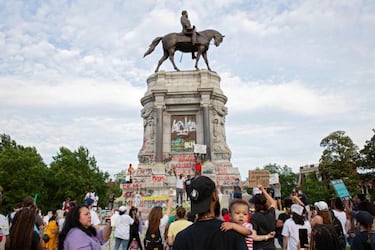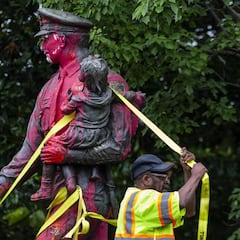What US military bases are named after Confederate generals?
After Donald Trump said US bases named after Confederate generals will not be renamed amid the George Floyd protests we take a look at the installations in question.

The ongoing protests following the death of George Floyd in Minneapolis on 25 May have spread across the globe and focused attention not only on contemporary issues of discrimination and prejudice but in the US also on historical issues surrounding the civil war and those states that promulgated slavery as a backdrop to the conflict. There have been calls across the United States for Confederate war memorials to be removed in the wake of the killing of the unarmed 46-year-old Floyd by former police officer Derek Chauvin. President Donald Trump has insisted he will “not even consider” changes to US military bases bearing the names of Confederate officers from the civil war, opining that they are a “part of a Great American Heritage, a history of Winning, Victory, and Freedom,” in a social media post. In the wake of George Floyd’s death, there are many who disagree.
Defense Secretary Mark Esper and Secretary of the US Army Ryan McCarthy have both indicated they would be open to discussions. However, Trump’s press secretary, Kayleigh McEnany, has said that even if a motion to change the names of the bases with Confederate links were to get past Congress, Trump would refuse to sign it.
There are a total of 10 US military bases named after Confederate general officers that would in theory be the subject of the debate should it ever reach the political sphere.
Fort Lee – Robert E. Lee

Fort Lee is located in Virginia and named after perhaps the most famous of all Confederate battlefield commanders, Robert. E. Lee.
Lee led to the Army of Northern Virginia from 1862 and won several engagements against larger Union formations but also oversaw the Confederate defeat at one of the decisive engagements of the civil war at Gettysburg. Lee eventually surrendered his army to Ulysses S. Grant on April 9, 1865 after the Battle of Appomattox Court House in Virginia.
Fort Lee is currently home to the Combined Arms Support Command.
Fort Bragg – Braxton Bragg
America's great military bases are known for the heroes within them, and any effort to change the names of these great forts is opposed by President @realDonaldTrump.
— Kayleigh McEnany 45 Archived (@PressSec45) June 11, 2020
President Trump will ALWAYS stand with our heroic military men and women! pic.twitter.com/BzCRVvtazq
Fort Bragg in North Carolina is the largest military base in the world and home to elite units including the 1st Special Forces Command, the 75th Ranger Regiment and the XVIII Airborne Corps, which encompassed the storied 82nd and 101st Airborne Divisions during the Second World War.
It is named after General Braxton Bragg, who served in the US Army in the Mexican-American War before declaring for the Confederacy at the outbreak of the civil war. Bragg too came up against US president-in-waiting Grant on the battlefield, besting the Union general at Chickamauga in 1863 before being defeated by the same opponent at the Second Battle of Chattanooga, which brought that campaign to an end and led to Bragg surrendering the city.
Fort Pickett – George Pickett
Like Fort Lee, Fort Pickett is also in Virginia and named after Confederate General George Pickett, who commanded one of the most famous single engagements of the entire civil war at Gettysburg.
Pickett’s Charge was Lee’s last-ditch attempt to overwhelm Union forces on the third day of Gettysburg and is considered the decisive action of the battle and the effective end of the Confederacy’s military parity with the Union. Pickett’s Charge involved some 12,500 Confederate soldiers but was a disaster, with the attackers losing around half of their number for no significant gain.
Fort Pickett currently houses the Virginia National Guard.
Fort A.P. Hill – Ambrose Powell Hill Jr.
Stand with us. Stand with Abraham Lincoln. Stand against Trump and the Confederacy.
— The Lincoln Project (@ProjectLincoln) June 13, 2020
Sign our petition now to take the names of Confederate Generals off of our military bases:https://t.co/wiLgy6Qe0D
Ambrose Powell Hill Jr. would not live to see the Confederate Army surrender as he was killed in battle during the Fall of Petersburg on 2 April, 1865.
Like Bragg, he was a US Army officer before declaring for the Confederacy and served in the Mexican-American War. Hill gained famed serving under Stonewall Jackson at Cedar Mountain, Second Bull Run, Antietam, and Fredericksburg.
Fort A. P. Hill in Virginia is currently a US military training facility.
Camp Beauregard – P.G.T. Beauregard
Another veteran of the Mexican-American War, the elaborately named Pierre Gustave Toutant-Beauregard was the fledgling Provisional Army of the Confederate States’ first brigadier-general and led the defence of Charleston at the outset of the war and was later involved in the First Battle of Bull Run (or Battle of Manassas), the opening major engagement of the civil war and a Confederate victory.
Camp Beauregard in Louisiana was set up during World War One and now serves as a training base for the Louisiana National Guard.
Fort Benning – Henry Benning
Speaker Pelosi is renewing a call to remove Confederate statutes from display in the US Capitol — a move that comes amid a national outcry over racial injustice and as Pres. Trump opposes efforts to remove Confederate commanders' names from military bases https://t.co/zw18R7e2ZL
— CNN (@CNN) June 11, 2020
Benning commanded the 17th Georgia Infantry under Robert E. Lee and saw action at the Second Battle of Bull Run, the Battle of Antietam and Gettysburg as a brigade commander.
Also established during WWI, Fort Benning in Georgia is now home to the U.S. Army Infantry School.
Fort Gordon – John Brown Gordon
Another World War I training base in Georgia, Fort Gordon houses the United States Army Signal Corps and the United States Army Cyber Corps. It is named after John Brown Gordon, who joined the Confederate Army as a captain in the 6th Alabama Infantry Regiment despite having no military experience but rose to become one of Lee’s most trusted generals during the war.
Fort Hood – John Bell Hood
The military career of John Bell Hood was a chequered one: after being promoted to the rank of general in 1864 to command the Army of Tennessee - becoming the youngest full general on either side in the civil war - he was later relieved of command after a series of defeats despite gaining a reputation as an extremely effective brigade and divisional commander early in the conflict.
Fort Hood in Texas was an anti-tank training facility during WWII that now serves as the headquarters of the US Army’s III Corps and First Army Division West and is home to the 1st Cavalry Division and 3rd Cavalry Regiment.
Fort Polk – Leonidas Polk
Leonidas Polk was a man of the cloth before the war and relation of the 11th US president, James K. Polk. “Sewanee's Fighting Bishop” enjoyed little success on the battlefield due to his inexperience and was killed in action during the Atlanta Campaign.
Fort Polk in Louisiana was founded during WWII and now serves as a training facility.
Fort Rucker – Edmund Rucker
Related stories
Rucker, an engineer before the conflict, is one of very few cases of an officer promoted from the ranks during the civil war, rising from a private in Tennessee Company of Sappers and Miners to colonel and commanding a brigade in the field. He was appointed an acting brigadier-general in 1864, although this rank was never ratified by the Confederate Congress.
Located in Alabama, Fort Rucker was inaugurated during WWII and is now a training centre for US Army pilots.


